http://greatergood.berkeley.edu/article/item/does_art_heal Does Art Heal?By
Meera Lee Sethi |
Winter 2009 |
3 commentsAt Shands HealthCare in Florida, artists and physicians have been partners for 18 years, reports Meera Lee Sethi. Their program is helping to prove the clinical benefits of creativity.
Seven-year-old Catriona Chennell’s room is filled with samples of her artwork: strings of differently-shaped beads, a painting of a rainbow blazing across a blue sky. For her most ambitious—and painstaking—piece so far, she glued small red and glass tiles onto a piece of ceramic about the length of her arm, shaped like a heart with wings.
The image is apt. Cat (as everyone calls her) has primary pulmonary hypertension (PPH), a rare and potentially life-threatening disorder characterized by abnormally high pressure in the artery carrying blood from the heart to the lungs. Like others with PPH, Cat’s heart is slowly enlarging from the stress of pumping hard enough to overcome the increased pressure. She experiences fatigue, pain, dizziness, and shortness of breath. “I also have a chest port,” she says, “so it doesn’t really feel comfortable.” This device, implanted beneath Cat’s skin, delivers a medication that dilates her blood vessels. “We’re talking about a seriously fragile kid,” says her grandmother, Lila Johnston.
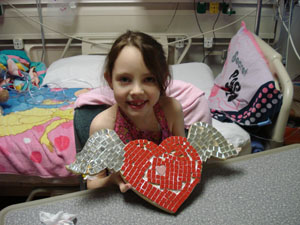
Courtesy of Shands Arts in Medicine
Cat’s art decorates her room in the pediatric intensive care unit at Shands at the University of Florida, the hospital in Gainesville where she has spent six months waiting for a heart-lung transplant that may one day enable her to play soccer—her second favorite hobby.
But Cat is too busy to dwell on her discomfort. Instead of spending time only with “my boring parents,” she is regularly visited by artists offering materials, project ideas, and instruction—part of a unique therapeutic program at
Shands known as Arts in Medicine (AIM). Cat has been at two other hospitals in Florida, but only here has she been given the opportunity to create art. “What a tremendous difference,” says her grandmother. “It really gets her mind off things.” For Cat, the point is simple. “I feel really good when I do art,” she says.
Cat is just one of thousands of patients to have been reached by AIM through Shands HealthCare, a network of hospitals and outpatient services affiliated with the University of Florida.
Through the AIM program, paid artists-in-residence and volunteers involve patients in creative activities like painting, writing, and singing. While the occasional hospital clown or musician is not uncommon elsewhere, Shands is the first institution of its kind to fully integrate the arts into its medical model. The AIM program doesn’t just operate once a month or week; it’s part of the care that patients receive every day, and AIM artists are in constant contact with physicians and nurses.
For years, AIM has been making hospital experiences less stressful. Staff and patients believe it has also done something more remarkable: improve patients’ health. Now, research documenting the therapeutic benefits of the arts is helping to explain why that might be the case. Together with stories from AIM, science is raising the provocative question: Does art heal?
My patient needs an artist
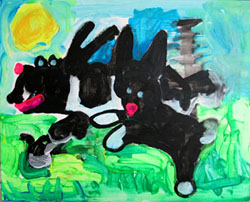
Courtesy of Shands Arts in Medicine
In 1990, John Graham-Pole was a pediatric oncologist at Shands with 25 years of medical experience. He was also a poet. Frustrated that “the art of medicine was getting lost under the weight of medical technology,” Graham-Pole began writing poems about the hospital. Poetry helped him come to terms with the reality of death, and he found solace in examining difficult experiences through the lens of art.
Wanting to share this experience, Graham-Pole and a fellow artist began holding their own informal arts workshops in a single hospital unit. He says their goal was never “curing disease.” Instead, they hoped to help both patients and staff “cope better with whatever was happening to them” through writing and painting. At first, Graham-Pole recalls, most doctors “couldn’t quite understand what this was about. But we became more and more bold with our presence in and around wards.”
Today, 18 years after its humble beginning, AIM runs on an annual budget of more than $350,000, operates in five different hospitals, and recruits 150 volunteers per year to support more than a dozen paid artists-in-residence. The artists each spend 10 to 20 hours a week in the hospital, using their professional expertise to organize a dizzying array of activities. On a typical day, one might hear a banjo player and a transplant patient singing together, see a dancer and a bed-ridden patient moving their arms in slow, undulating waves, or encounter a theatrical performance in a hospital atrium. And AIM programs reach beyond patients: Medical students participate in reflective writing exercises, there are weekly meditation classes for nurses and doctors, and visiting family members are often drawn into AIM sessions. Shands also installs fine art and patient art—like Cat’s heart with wings—on hospital walls.
AIM artists are overseen by a small group of administrative staff, who hold weekly conferences and receive patient referrals. Tina Mullen, AIM’s director, explains that clinicians at Shands don’t see art as a frill at the hospital; they’re convinced it provides real health benefits. That’s why they take the time to make referrals. “The nursing staff and medical staff are making judgments about when to use art as one of the therapies at their disposal,” says Mullen. “They’re saying, ‘My patient needs to see an artist today.’”
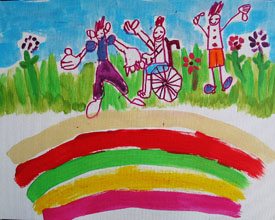
Courtesy of Shands Arts in Medicine
Research suggests that such judgments are grounded in scientific evidence. A study at the State University of New York, Buffalo, in 2001, for example, found that patients who listened to their choice of music before, during, and after eye surgery experienced lower blood pressure and heart rates, and less perceived stress. In another study, published in the February 2006 issue of the
Journal of Pain and Symptom Management, cancer patients who participated in a visual art session reported feeling less pain, tiredness, drowsiness, and breathlessness afterwards.
Indeed, scientists have documented health benefits from exposure to art at all stages of life. Lullabies have been shown to promote neurological development and weight gain in premature infants, while dance appears to help elderly
patients with dementia retain greater intellectual, emotional, and motor functions.
To Lauren Arce, a transplant nurse at Shands and a dancer-in-residence, AIM brings these kinds of results to life. In her decade with the program, she says she’s seen the arts bring a host of improvements to patients’ health, from reduced anxiety and shorter hospital stays to diminished feelings of pain and lower blood pressure.
Arce recalls a 12-year-old girl with cystic fibrosis, struggling with the final stages of her disease. Two AIM artists, a painter and a musician, visited her room bearing rocks for a medicine wheel, a traditional Native American artifact associated with healing. The girl had an elevated heart rate and low blood saturation—low levels of oxygen in her bloodstream—and was too weak and uncomfortable to paint a rock herself. But she picked out several for her family and instructed the artist to paint specific images on each of them. She also requested a song from the musician: “Amazing Grace.” As the song played, says Arce, the adults in the room were in tears, but the girl seemed to become more comfortable. “You could see her muscles relaxing, her blood pressure lowering, her heart rate going down, her blood saturation levels going up,” she says.
This would not surprise Graham-Pole, who tells of a Shands patient with a particularly painful case of sickle-cell disease. Movement sessions with dancer-in-residence Jill Sonke-Henderson brought her so much relief that her doctors soon became used to an unusual cry: “Don’t give me morphine, just bring the dancer!”
Other effects are more subtle. Sonke-Henderson notes that positive experiences with movement can be therapeutic for people who feel disconnected from, or “let down” by, their bodies. She describes going through an exercise with a bone marrow transplant patient who said the beach was her favorite place. They closed their eyes, stretched their arms toward the horizon, and reached down as if to scoop up water. Then, Sonke-Henderson recalls, the patient “took a deep breath and said, ‘Now I know I’m going to be all right; the seashells all turned to jewels.’”
The image is startlingly ethereal, but seeing those jewels may have had a concrete physiological impact. A 2007 study from the Journal of Psychosocial Oncology, for instance, found that pre-surgery optimism in bone marrow transplant patients is associated with better survival rates in the first year after surgery.
More than a diagnosis
Why might the arts provide such benefits? Artists at Shands have some ideas. They say artistic processes restore a sense of identity and agency that hospitalization takes away. Barb Esrig, once attended by AIM artists after a car wreck broke 164 bones in her body, now interviews Shands patients for oral histories. She says AIM “reminds people they’re a whole lot more than just a disease process or a diagnosis. We find out who they are outside of the hospital gown.”
Paula Patterson agrees. She leads a theater troupe whose members listen to patients speak about their lives, then “play back” the patients’ stories by transforming them into theater pieces. Patterson remembers a patient who, enthralled by seeing her life turned into drama, decided to join the group herself. The woman had an IV pole by her side, so she draped it in black cloth and gamely dubbed it “Ivy.”
“She learned that her story was worthy of being art,” says Patterson. “And when she became a performer, rather than being the person who always received help, she could be giving help to others.”
Some scientists believe that such feelings of control and mastery trigger an increase in the production of disease-fighting cells. A 2004 study found that HIV-positive patients who engaged in expressive writing, or writing exercises specifically designed to help them process traumatic events, had higher levels of a particular group of white blood cells known as CD4 lymphocytes.
Other research reveals different mechanisms by which art may improve health. A 2006 study tested the saliva of college-aged singers before and after rehearsals. Singing appeared to raise their levels of salivary immunoglobulin, a substance that defends the respiratory tract against pathogens. And singers who were pleased with their performances had lower levels of cortisol, a hormone that is a marker for stress, in their saliva. In other words, artistic engagement doesn’t just make people feel better in the moment—it may protect their future health by boosting their immune systems.
The arts can play a role in medicine in more basic ways. When a physician at Shands studied the health of patients at an outpatient hemodialysis unit, he found that AIM patients not only gained less weight (a good thing for many of those on dialysis therapy), lowered blood pressure, and improved mood, they were also more likely to take their medication consistently after they left the clinic, reducing their risk of complications. Findings like this, Mullen explains, are why “more and more institutions are coming to Shands and saying, ‘We’d like to learn about this!’”
Graham-Pole, now retired, envisions a world in which art is an integral part of every health care system. He says a model of medicine that embraces the arts is extremely cost-effective when one considers the impact of the AIM program and its “tiny” budget, relative to the overall cost of running a hospital.
“Art is a social determinant of our health,” he says. “It doesn’t cure a particular disease, but benefits whatever ails you.”

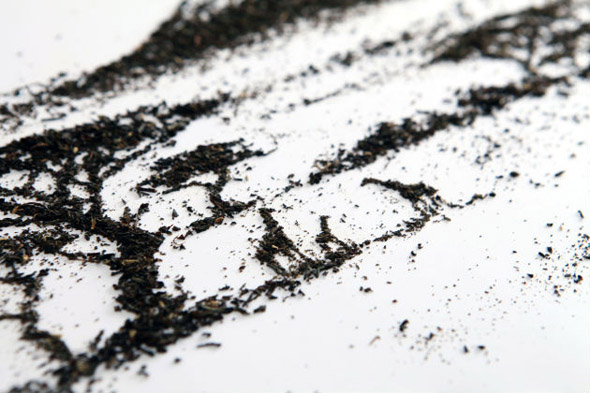





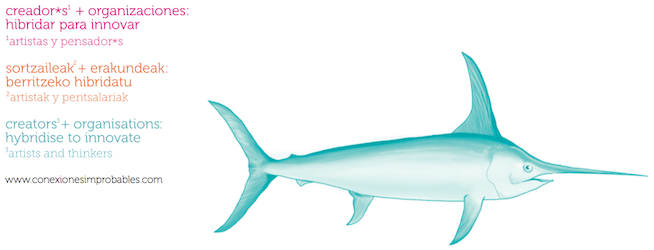
 Courtesy of Shands Arts in Medicine
Courtesy of Shands Arts in Medicine Courtesy of Shands Arts in Medicine
Courtesy of Shands Arts in Medicine Courtesy of Shands Arts in Medicine
Courtesy of Shands Arts in Medicine

